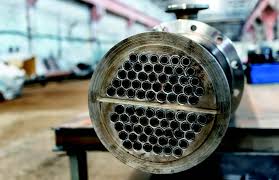Introduction
In heat exchanger systems, selecting compatible tube bundles is a critical decision that directly impacts performance, maintenance, and longevity. Tube bundles are the core component where heat transfer between fluids occurs, making their material compatibility and design essential to the unit’s overall function. When tube bundles are matched to the specific operating conditions—such as temperature, pressure, and fluid characteristics—the heat exchanger operates efficiently and reliably, minimizing risks like corrosion, fouling, and thermal fatigue. This introduction explores the importance of choosing compatible tube bundles for optimized heat transfer, cost-effectiveness, and durability in various industrial applications, underscoring their vital role in effective maintenance practices.
Material Compatibility: Selecting tube bundles made of materials compatible with the fluids used prevents corrosion and erosion. For example, if the fluids are corrosive, materials like stainless steel or titanium are more suitable, as they offer resistance and extend the life of the exchanger.
Thermal Expansion and Stress: Different materials expand and contract at varying rates under temperature fluctuations. Using compatible tube materials ensures uniform expansion, reducing stress and minimizing the risk of cracking or leaks that could otherwise compromise performance.
Enhanced Heat Transfer Efficiency: Compatible tube bundles maintain an optimal balance between heat transfer and fluid resistance. If materials and configurations are mismatched, they may impair efficiency, leading to poor thermal performance and increased operational costs.
Ease of Maintenance and Replacement: Properly selected tube bundles simplify cleaning, inspection, and repairs. Compatibility with the exchanger design means that tube bundles can be accessed, cleaned, or replaced without complex procedures, reducing downtime and costs.
Safety and Compliance: In industries handling hazardous fluids, compatible materials are critical to maintaining a safe operating environment. Certain materials meet industry standards for specific applications, ensuring the heat exchanger operates within safe, regulated conditions.
Minimizing Fouling and Scaling: Using compatible tube materials reduces fouling and scaling, especially in applications involving hard water or mineral-rich fluids. Some materials are less prone to fouling, which helps maintain efficient heat transfer over time and lowers the frequency of maintenance.
Optimizing Operating Pressure: Tube bundle compatibility with the operating pressure range of the heat exchanger ensures structural integrity. High-pressure systems, for example, require durable materials like stainless steel or carbon steel to withstand the stresses. This compatibility helps avoid pressure-related failures and ensures stable performance.
Preventing Cross-Contamination: In processes involving sensitive or hazardous fluids, selecting compatible tube bundles is crucial to avoid cross-contamination. Compatible materials prevent leaks or seepage between the shell and tube sides, which is essential in food processing, pharmaceuticals, and petrochemical industries.
Improved Energy Efficiency: A well-matched tube bundle maximizes heat transfer efficiency, reducing energy consumption. When the materials and design are optimized for the specific thermal properties of the fluids, the exchanger operates more efficiently, conserving energy and lowering operational costs.
Extended Equipment Lifespan: Compatible tube bundles help prolong the overall life of the heat exchanger. Mismatched materials can cause premature wear, requiring frequent replacements. A well-suited tube bundle minimizes wear and tear, extending equipment longevity and reducing total maintenance costs.
Reduced Risk of Thermal Fatigue: High-temperature applications can cause thermal fatigue if the tube bundle materials aren’t compatible with the thermal conditions. Using thermally stable materials prevents cracking and other damage from repeated heating and cooling cycles, especially in extreme applications.
Adaptability for Process Changes: In cases where process conditions or fluid types might change, compatible tube bundles allow for flexibility without compromising performance. Choosing materials that can handle varying conditions provides versatility, helping the heat exchanger adapt without significant retrofitting.
Compliance with Industry Standards: Industry standards like ASME and TEMA have material guidelines based on application type, temperature, and pressure. Choosing tube bundles that meet these standards ensures the equipment adheres to regulatory requirements, enhancing safety and reliability.
Lower Environmental Impact: Efficient and long-lasting tube bundles reduce the need for frequent replacements and repairs, which minimizes material waste. Additionally, materials that resist corrosion and fouling prevent leaks, contributing to environmental sustainability by reducing the risk of harmful fluid discharge.
Conclusion
selecting compatible tube bundles is foundational to the efficient, safe, and long-lasting performance of heat exchangers. By choosing tube materials and designs that align with specific operational requirements—such as temperature, pressure, and fluid types—industries can enhance heat transfer efficiency, reduce maintenance frequency, and avoid costly downtime. Compatibility not only extends the lifespan of the heat exchanger but also ensures environmental safety and regulatory compliance, particularly in sensitive applications. Investing in compatible tube bundles ultimately provides long-term cost savings, reliability, and operational resilience, making it an essential aspect of effective heat exchanger maintenance.

